Small overlap front: driver-side
Rating applies to 2010-15 models
Tested vehicle: 2013 Hyundai Tucson GLS 4-door 4wd
The Hyundai Tucson was redesigned for the 2010 model year, and the Kia Sportage was redesigned for the 2011 model year. The small overlap frontal ratings apply to 2010-15 models of the Tucson and to 2011-16 models of the Sportage.
| Evaluation criteria | Rating |
|---|---|
| Structure and safety cage | |
| Driver injury measures | |
| Head/neck | |
| Chest | |
| Hip/thigh | |
| Lower leg/foot | |
| Driver restraints and dummy kinematics The dummy’s head barely contacted the frontal airbag before sliding off the left side as the steering column moved 14 cm to the right. Additionally, the seat belt allowed excessive forward excursion of the dummy’s head and torso, contributing to the head hitting the instrument panel. The side curtain airbag did not deploy, leaving the dummy's head vulnerable to contacts with side structure and outside objects. | |
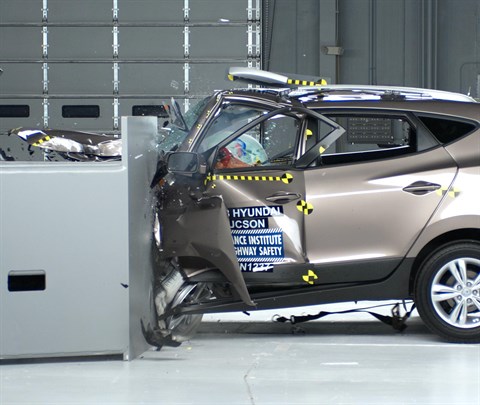
Action shot taken during the small overlap frontal crash test.
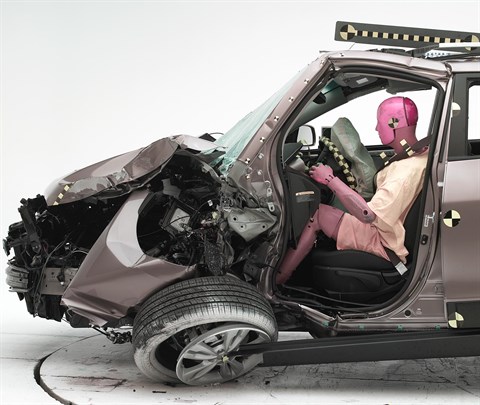
The dummy's position in relation to the door frame, steering wheel, and instrument panel after the crash test indicates that the driver's survival space wasn't maintained well.
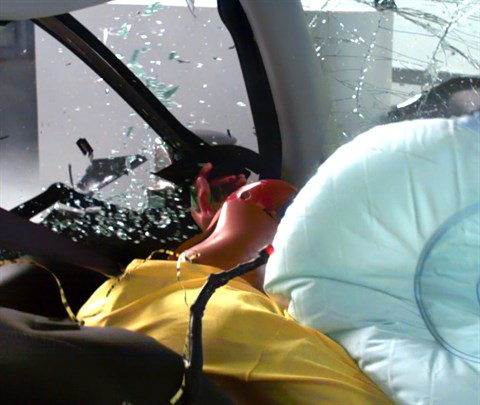
During the crash, the dummy's head and torso barely contacted the airbag before sliding off to the left, and the seat belt allowed the dummy to move too far forward, as is evident from the gap between the seat back and the dummy's torso.
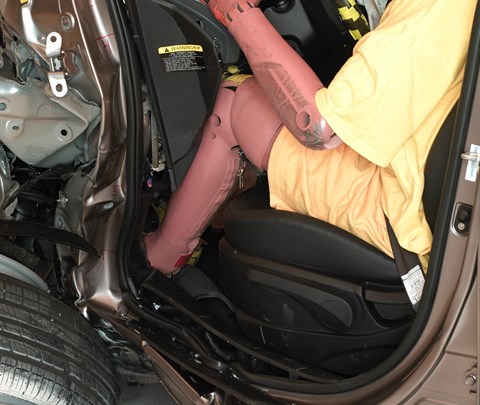
Parking brake pedal (not visible), instrument panel, and door hinge pillar intrusion was extensive as the left front wheel was forced rearward during the crash. (The tire can be seen below the dummy's ankle.) This intrusion contributed to a significant risk of injury to the left knee and a moderate risk to the left lower leg.
Moderate overlap front: original test
Rating applies to 2010-15 models
Tested vehicle: 2010 Hyundai Tucson GLS 4-door 4wd
The Hyundai Tucson was redesigned for the 2010 model year, and the Kia Sportage was redesigned for the 2011 model year. The moderate overlap frontal ratings apply to 2010-15 models of the Tucson and to 2011-16 models of the Sportage.
| Evaluation criteria | Rating |
|---|---|
| Overall evaluation | |
| Structure and safety cage | |
| Driver injury measures | |
| Head/neck | |
| Chest | |
| Leg/foot, left | |
| Leg/foot, right | |
| Driver restraints and dummy kinematics | |

Action shot taken during the frontal offset crash test.
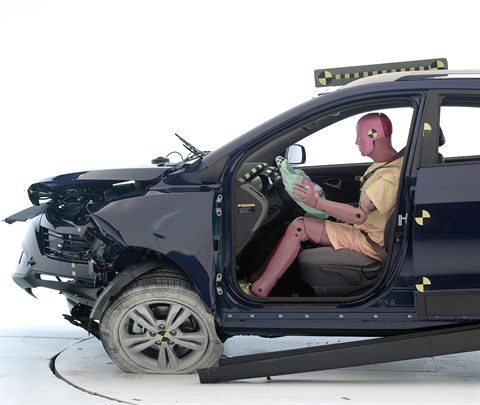
The dummy's position in relation to the steering wheel and instrument panel after the crash test indicates that the driver's survival space was maintained well.
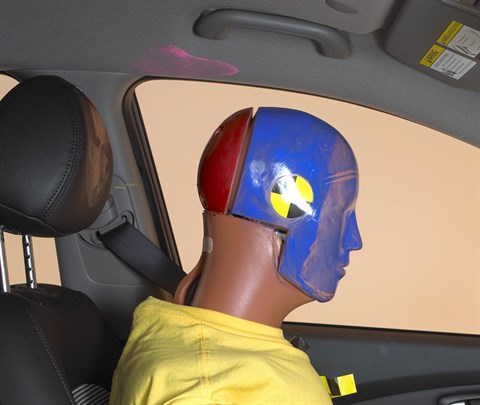
Smeared pink greasepaint indicates where the dummy's head hit the roof rail during rebound. Head acceleration from this hit was negligible.
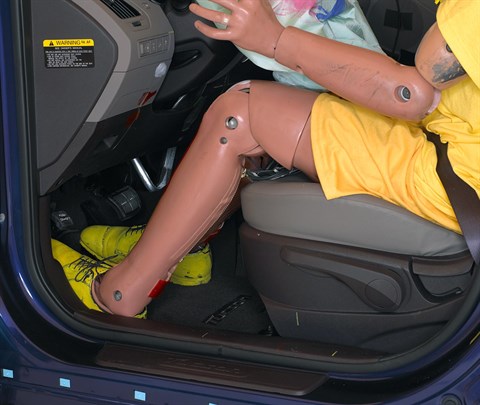
Intrusion into the driver's space was minimal, and all leg and foot injury measures were low.
Side: original test
Rating applies to 2010-15 models
Tested vehicle: 2010 Hyundai Tucson GLS 4-door 4wd with standard front and rear head curtain airbags and standard front seat-mounted torso airbags
The Hyundai Tucson was redesigned for the 2010 model year, and the Kia Sportage was redesigned for the 2011 model year. The side ratings apply to 2010-15 models of the Tucson and only to 2011 models of the Sportage.
| Evaluation criteria | Rating |
|---|---|
| Overall evaluation | |
| Structure and safety cage | |
| Driver injury measures | |
| Head/neck | |
| Torso | |
| Pelvis/leg | |
| Driver head protection | |
| Rear passenger injury measures | |
| Head/neck | |
| Torso | |
| Pelvis/leg | |
| Rear passenger head protection | |

View of the vehicle and barrier just after the crash test.
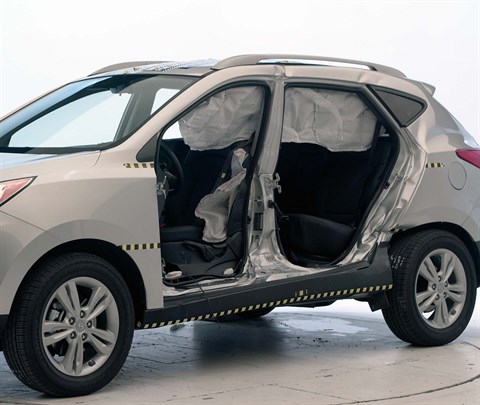
View of the vehicle after the crash with doors removed, showing the side airbags and damage to the occupant compartment.
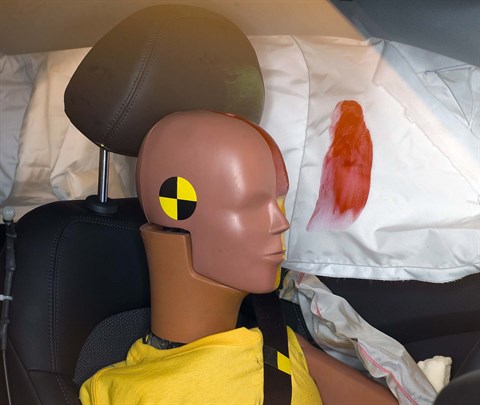
Smeared greasepaint shows where the driver dummy's head was protected from being hit by hard structures by the side curtain airbag (paint on side torso airbag not readily visible).
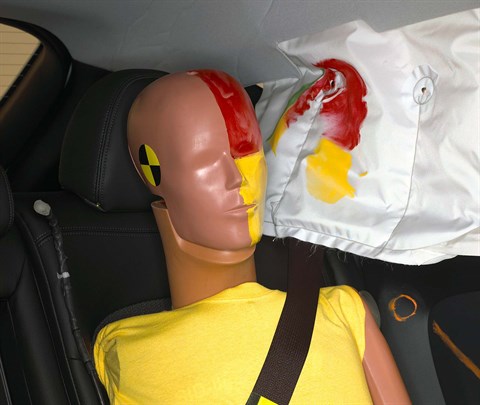
Smeared greasepaint shows where the rear passenger dummy’s head was protected by the side airbag.
Roof strength
Rating applies to 2010-15 models
Tested vehicle: 2010 Hyundai Tucson GLS 4-door 4wd
| Overall evaluation | |
|---|---|
| Curb weight | 3,359 lbs |
| Peak force | 14,887 lbs |
| Strength-to-weight ratio | 4.43 |
Head restraints & seats
Seat type: Manual seats AHR
| Overall evaluation | |
|---|---|
| Dynamic rating | |
| Seat/head restraint geometry |
About the head restraint & seat test
Currently, IIHS tests apply only to front seats.
